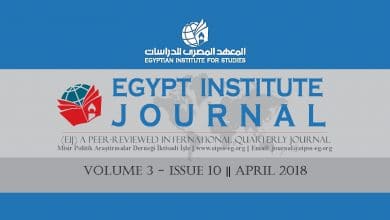
Egypt Institute Journal (Vol. 3 – Issue 9)
Introduction of Egypt Institute Journal (Vol. 3 – Issue 9)
Issue No.9 of the Egypt Institute Journal, published in July 2016, included a number of political, strategic, economic, intellectual and legal articles, as follows:
1- ‘Citizenship in a Muslim Country: Problems and Challenges, by Dr. Saif Al-Din Abdel-Fattah:
The study seeks to investigate the features of citizenship, extract its real dimensions and features, and root awareness of its significance based on the values of Islam and its historical experience in light of the State that was founded by Prophet Mohammad (PBUH), as it is considered the legal and historical model reference that Muslims and others should resort to in controlling the normative limits of the principle of citizenship and addressing the problems and challenges it faces by adopting Islamic mechanisms and recipes that are compatible with the spirit of the age. In light of this, it is possible to construct a hypothesis that: “The peculiarity of the approach has established a balanced structure for citizenship that absorbs the intersections of corresponding affiliations of the Muslim individual without compromising the priority of belonging to the Islamic identity associated with reference or ‘authority’ and achievement of its requirements.”
2- ‘Fighting Hamas: Policies of Palestinian Authority and the Occupation’, by Israa Lafi:
A new Palestinian reality emerged after the 2006 elections when Hamas controlled Gaza and Fatah controlled the West Bank. Within this context, this study addresses the policies of fighting Hamas in five axes:
1- A summary of the reality experienced by the movement during 12 years,
2- The policies of the Palestinian Authority and the Israeli occupation in targeting the movement,
3- The internal circumstances that contributed to the weakening of Hamas,
4- The events that gave Hamas a chance to catch its breath and restore its organization, and
5- The main challenges and ways to overcome them.
3- “From ‘Tawhid and Jihad’ to ‘Ansar Bayt Al-Maqdis’”, by Ahmed Mawlana:
The “Ansar Bayt al-Maqdis” group is one of the most prominent jihadist groups that appeared in the Egyptian scene after the outbreak of the January 25 revolution, 2011, and became popular after the military coup in 2013. The jihadist group had operated under this name until November 2014, when it pledged allegiance to the Islamic State (in a nine-minute audio released on Twitter) and changed its name to become “Sinai Province”. This study addresses the roots of the group which trace back to the “Tawhid and Jihad” group that carried out several attacks against tourists in the Sinai Peninsula in 2004 and 2005. Before examining the experience of ‘Ansar Bayt al-Maqdis, the study addresses the experience of the ‘Tawhid and Jihad’ group as it represents the original or parent group of the former.
4- ‘Egyptian Army: Composition and Deployment Maps’, by Mahmoud Gamal:
The army’s units and military formations within the borders of any country are usually deployed over all its strategic directions in order to protect the state from any potential threat. But, when there is a threat coming from one direction, such as hostility with a neighboring country, the Army, in this case, deploys its forces massively in that direction, in order to preserve the national security of the state.
Deployment of armies and military zones within the borders of the State is defined in the military doctrine under the axis of ‘environmental doctrine’, which is the second type of military doctrine at the operational level, while the proliferation of military formations within the borders of the State is in accordance with the organizational doctrine of the armies. Within these considerations, the study deals with field armies, military zones, special units in the Egyptian army, air bases and military airports, and Egyptian naval bases; and then addresses the military vision in deployment of the Egyptian army formations.
Egypt Institute Journal (Vol. 3 – Issue 9) link
To Read Text in PDF Format Click here.



